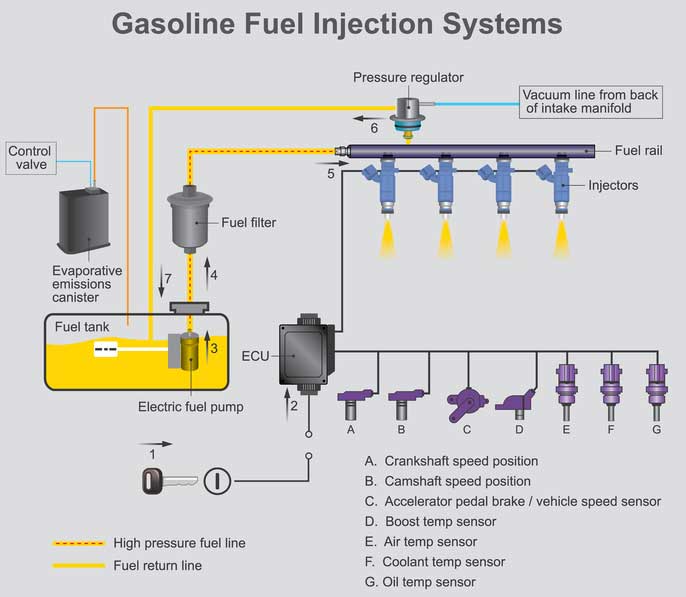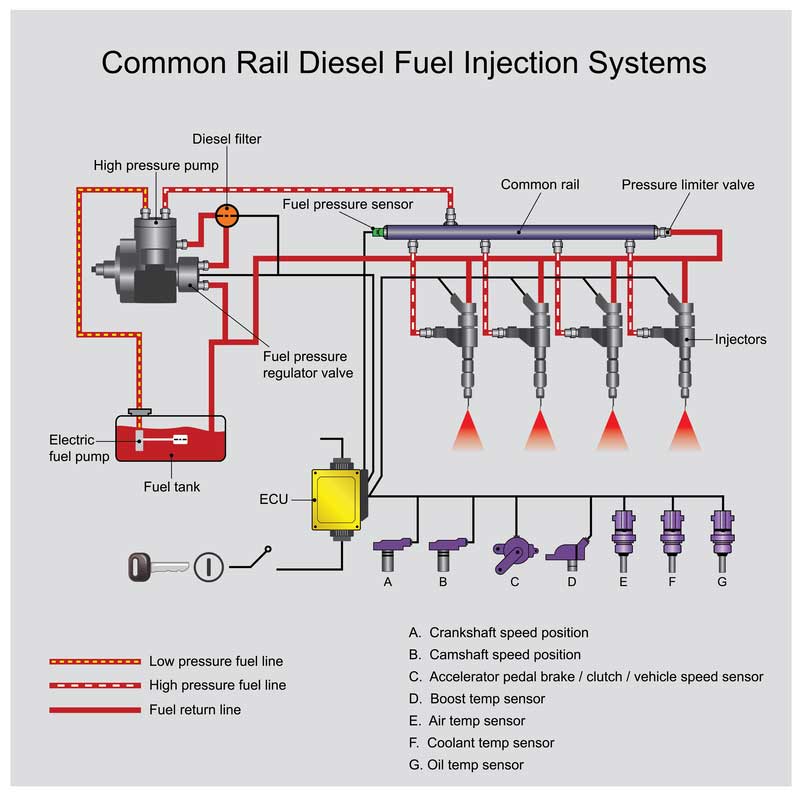The fuel pressure regulator is designed with unique features that provide the required pressure on fuel entering the combustion chamber.
It works according to the capability of the fuel injector system by providing enough fuel pressure that the Fuel Injector System can hold or allow.
The amount of fuel injected into modern engines depends on when the injectors are opened. Therefore, the difference between the fuel pressure in the rail and the air pressure in the intake manifold must remain constant regardless of the engine’s operating conditions.
In order to ensure this pressure difference, it is necessary to use a device that adjusts the fuel pressure in the rail according to the variation of air pressure in the intake manifold.
You may not be aware of a fuel pressure regulator in your car, but it is a sensitive part that the car won’t function without it. For every system operating under EFI, like your car, a fuel pressure regulator is a must.
Contents
What is a fuel pressure regulator?
A fuel pressure regulator is a system that works by controlling the pressure applied on the fuel entering the engine via the fuel injectors.
If the fuel pressure regulator is absent, the fuel will enter the vehicle’s systems straight without reaching injectors. The role of a pressure regulator is to ensure that there is a steady fuel supply that will keep the car moving smoothly.
In its structure, the fuel pressure regulator contains a diaphragm for controlling the ball seat or the bypass valve. The bypass valve opens and closes for proper adjustment for steady fuel delivery to allow fuel to pass through.

Upon applying boost on the pressure regulator, the attached diaphragm on the ball seat moves down, and excess fuel supply is reduced.
This technique makes the fuel pump function with difficulties, and as a result, the fuel pressure and boost pressure of the manifold intake increase.
However, for the fuel pressure regulator to work perfectly, the fuel to air ratio must be 1:1. Since there are two sides on the fuel injector, one side is kept under pressure by the fuel rail, and the other is acted upon by the turbo/compressor boosted air.
This fuel-air ratio is sufficient to enable the fuel injector to keep the pressure that balances the steady fuel delivery.
Depending on the number and positioning of the fuel and air connections, there are several types of pressure regulators. Also, these can be with fuel return in the tank or without return, but the most commonly used ones are those with a return.
In case the pressure regulator fails to compensate for the injection pressure, depending on the air pressure in the intake manifold, it will not be done again.

For this reason, the quantity of fuel injected into the cylinders will no longer be controlled resulting in abnormal engine operation.
Because it’s a little bit hard for the ECU to diagnose the problems that the pressure regulator has, often the ECU will give some false alarms like there are some problems with the oxygen sensor and the injectors.
Symptoms of a bad or failing fuel pressure regulator
Like any other car part, a fuel pressure regulator can encounter some issues, and the entire car’s health becomes negatively affected.
When the car is under mechanical problems, some parts with issues share common signs and symptoms; therefore, you may not know what the issue is.
However, if you notice some symptoms mentioned below, your car could be experiencing a bad fuel pressure regulator. The pressure regulator controls the fuel pressure on the rail. If it fails, it will affect the amount of fuel injected.
1. Noisy Fuel Pump
Although it’s normal for the fuel pump to produce a humming sound while in use, sometimes the sound can be irritating when the fuel pressure regulator goes bad.
If you hear a whirring noise coming from the fuel pump, especially when in a traffic jam or when you slow down your car, definitely think about your car’s fuel pressure regulator being damaged.
2. Fuel leaks
Sometimes, the seal on the diaphragm of the fuel pressure regulator may fail or get damaged, and as a result, fuel starts leaking. When there is fuel leakage, the car’s performance may go down.
3. Engine Malfunction
If your car’s engine is malfunctioning, one cause could be a bad fuel pressure regulator. This will be a result of leaking fuel through the tailpipe.
What results in tailpipe fuel leaking is the exhaust system getting overfilled or fuel lines being flooded by the excess flue.
4. Misfire and engine power loss
If your car is encountering some problems with engine performance, it is one sign and symptom of a failed fuel pressure regulator.
The work of a fuel pressure regulator is to provide sufficient pressure that controls fuel entering the engine to ensure smooth driving.
If there is a problem in such a system, it means the intended goal is not met. In other words, a faulty fuel pressure regulator will interrupt the fuel delivery in the Engine. As a result, the fuel-air ratio becomes irregular and will result in an engine misfire and low performance.
5. Drop on fuel consumption economy
If the diaphragm seal of the fuel pressure regulator fails, much fuel leaks out. Fuel leaking is fuel wastage; therefore, the fuel consumption becomes uneconomical.
Other symptoms
- A difficult engine start or doesn’t start at ll, especially when the engine is cold;
- At idle the engine RPM is unstable, the engine may stop;
- Black smoke from the exhaust
- Low fuel pressure
- Buildups can form on the spark plugs
Another common symptom is having the flexible membrane cracked or broken. This fault can be seen easily:
- Ensure to check the connection with the intake air pipe and see of ot has traces of gas.
- The fuel pump will start to create pressure in the circuit and if the membrane is cracked, the fuel will exit through the air connection crack when the egine is on.
- Check all the connecting pipes (fuel, air) to make sure they do not have cracks before checking the actual part.
How to check a fuel pressure regualtor
To check the fuel pressure regulator, you can use a pressure gauge that will be connected to a valve specially provided for this purpose, located on the motor supply circuit.
Connect the pressure gauge making sure the engine is off. Start the engine and read the fuel pressure both at idle speed and with a pressed accelerator pedal.
If the pressure is above the values indicated by the car manual or if it does not vary with the gas pedal position then the pressure regulator may have issues.
The costs of replacing a bad fuel pressure regulator
The cost of replacing a bad fuel pressure regulator varies from the region, the type of mechanic, and the nature of the FPR. However, replacing a bad fuel pressure regulator will cost you around $150-$350, although the cost can go higher due to other factors.
This cost includes labor and the buying cost of fuel pressure regulator material. The labor may cost you around $80-$140, while buying materials may cost you between $60-$240.
Conclusion
Fuel Pressure Regulator plays an important role in providing steady fuel flow in your car. However, it can experience problems that need to be addressed immediately for the car to continue moving smoothly.
If you see your car’s performance dropping, fuel economy dropping, or black smoke exhaustion, you need to reach your mechanics for a check-up. If the problems are resulting due to a bad fuel pressure regulator, there is a need for replacement.
